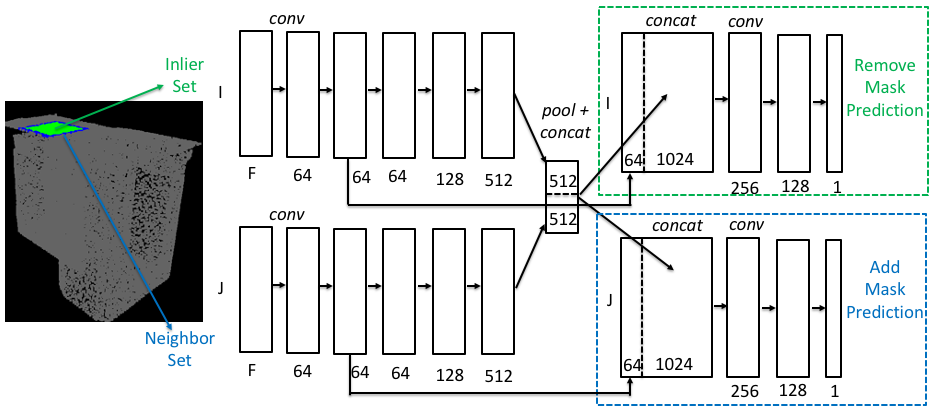LRGNet: Learnable Region Growing for Point Cloud Segmentation
This repository contains code for the RAL paper LRGNet: Learnable Region Growing for Class-Agnostic Point Cloud Segmentation.
Environment Setup and Dependencies
This environment setup is designed for Tensorflow 2.x with NVIDIA RTX series GPUs. For Tensorflow 1.x, it is suggested to checkout the tensorflow-gpu==1.15.4 branch and use NVIDIA GTX series GPUs with tensorflow==1.15.4. This setup is known to work with NVIDIA RTX 3070 and RTX A6000 GPUs. Credits to Andre Longon from Louisiana State University for helping to port the code to Tensorflow 2.
-
python==3.8
-
tensorflow-gpu==2.6.0
-
cudatoolkit==11.3.1
conda env create -f environment.yml -n lrgnet conda activate lrgnet pip install scikit-learn networkx h5py
Data Staging
Run the following script to download the necessary point cloud files in H5 format to the data folder.
bash download_data.sh
To use the Semantic KITTI dataset, follow the instructions on the Semantic KITTI website and then run the following script:
python stage_semantic_kitti.py --dataset semantic_kitti/dataset/ --output data/kitti_train.h5 --sequences 00,01,02,03,04,05,06,07,09,10
python stage_semantic_kitti.py --dataset semantic_kitti/dataset/ --output data/kitti_val.h5 --sequences 08
Data Visualization
To check the data shape/size contained in each H5 file:
python examine_h5.py data/scannet.h5
<HDF5 dataset "count_room": shape (312,), type "<i4">
<HDF5 dataset "points": shape (7924044, 8), type "<f4">
To convert the H5 data file into individual point cloud files (PLY) in format, run the script as follows. PLY files can be opened using the CloudCompare program
#Render the point clouds in original RGB color
python h5_to_ply.py data/s3dis_area3.h5 --rgb
#Render the point clouds colored according to segmentation ID
python h5_to_ply.py data/s3dis_area3.h5 --seg...
Saved to data/viz/22.ply: (18464 points)
Saved to data/viz/23.ply: (20749 points)
To plot the instance color legend for a target room:
#Plot color legend for room #100 in ScanNet
python h5_to_ply.py data/scannet.h5 --target 100Benchmarks
Train benchmark networks such as PointNet and PointNet++ (pointnet2).
python train_pointnet.py --mode pointnet --train-area 1,2,3,4,6 --val-area 5Run benchmark algorithms on each dataset. Mode is one of normal, color, curvature, pointnet, pointnet2, edge, smoothness, fpfh, feature.
python benchmarks.py --mode normal --area 5 --threshold 0.99 --saveEvaluate the cross-domain performance as follows:
python train_pointnet.py --mode pointnet --train-area scannet --val-area s3dis --cross-domain
python benchmarks.py --mode pointnet --train-area scannet --area s3dis --cross-domainEvaluate the performance on the Semantic KITTI dataset as follows:
python benchmarks.py --mode feature --area kitti_val --resolution 0.3
python train_pointnet.py --mode pointnet --train-area kitti_train --val-area kitti_val
python benchmarks.py --mode pointnet --train-area kitti_train --area kitti_val --resolution 0.3Learn Region Grow (LRGNet)
Run region growing simulations to stage ground truth data for LRGNet.
python stage_data.py
#To apply data augmentation, run stage_data with different random seeds
for i in 0 1 2 3 4 5 6 7
do
for j in s3dis scannet
do
python stage_data.py --seed $i --area $j
done
doneTrain LRGNet for each area of the S3DIS dataset.
python train_region_grow.py --train-area 1,2,3,4,6 --val-area 5Test LrgNet and measure the accuracy metrics.
python test_region_grow.py --area 5 --save
python test_region_grow.py --area scannet --saveTest LRGNet using local search methods
python test_random_restart.py --area 5 --scoring ml
python test_random_restart.py --area 5 --scoring np
python test_beam_search.py --area 5 --scoring ml
python test_beam_search.py --area 5 --scoring npEvaluate the cross-domain performance as follows:
python train_region_grow.py --train-area scannet --cross-domain
python test_region_grow.py --train-area scannet --area s3dis --cross-domain
python test_random_restart.py --train-area scannet --area s3dis --cross-domain --scoring npEvaluate the performance on the Semantic KITTI dataset as follows:
for i in 01 02 03 04 05 06 07 09 10
do
python stage_semantic_kitti.py --dataset semantic_kitti/dataset/ --output data/kitti_train_"$i".h5 --sequences $i --skip 1
done
for i in 0 1 2 3 4 5 6 7 9 10
do
python stage_data.py --area kitti_train --resolution 0.3 --seed $i
done
python train_region_grow.py --train-area kitti_train --val-area kitti_val --multiseed 11
python test_region_grow.py --area kitti_val --resolution 0.3 --saveResults
Segmentation results on S3DIS dataset
Segmentation results on ScanNet dataset
Segmentation results on Semantic KITTI dataset
Citation
@ARTICLE{chen2021ral,
author={J. {Chen} and Z. {Kira} and Y. K. {Cho}},
journal={IEEE Robotics and Automation Letters},
title={LRGNet: Learnable Region Growing for Class-Agnostic Point Cloud Segmentation},
year={2021},
volume={6},
number={2},
pages={2799-2806},
doi={10.1109/LRA.2021.3062607},
}



